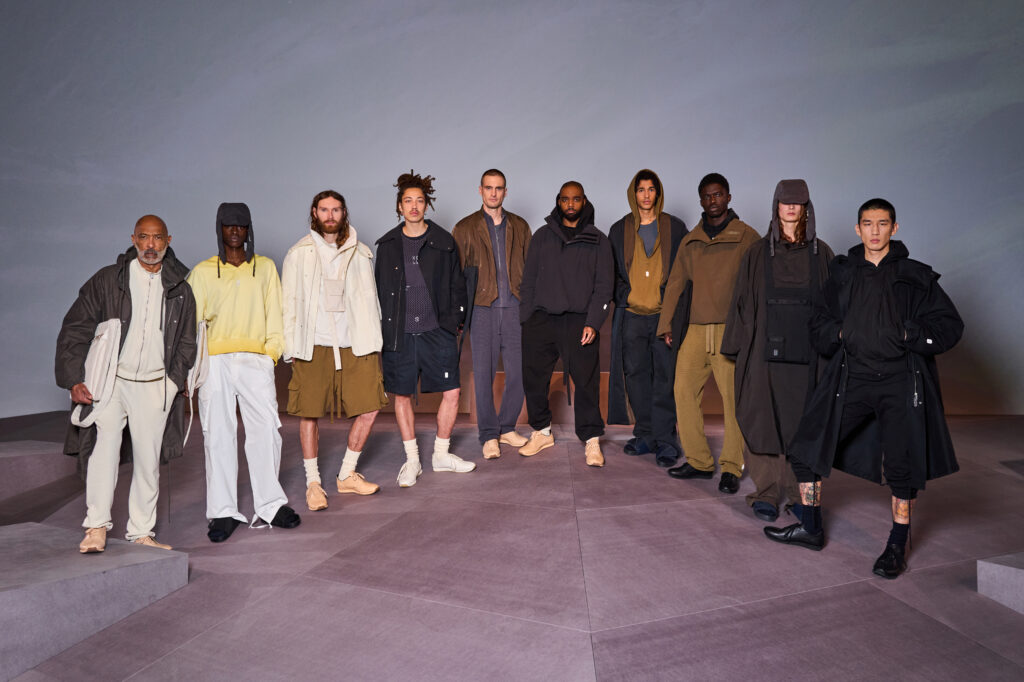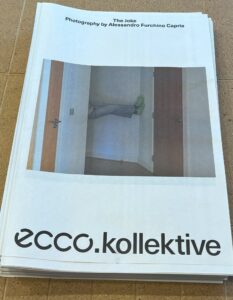The partnership between Samuel Ross and ZARA returns this season under the banner SR_A Engineered by ZARA, marking its second chapter — a more refined, conceptual, and mature evolution of a connection that has already reshaped how design innovation and accessibility can coexist. The inaugural collection in early 2025 introduced the concept of democratized high design: garments that carried Ross’s signature industrial and architectural sensibility but were crafted at a scale that made them attainable to the broader public.
This second installment expands upon that vision. It sharpens the line’s focus, both in execution and ideology, embracing new materials, proportion refinement, and a deeper understanding of the modern uniform. It is not a reinvention, but a continuation — an act of editing rather than rebuilding.
atelier
Samuel Ross has always blurred the boundaries between art, design, and fashion. His studio SR_A (Samuel Ross Atelier / Studio Research & Attire) acts as a creative ecosystem rather than a traditional fashion house. It encompasses furniture, sculpture, product design, and garments — all of which reflect Ross’s fascination with structure, form, and the built environment.
The connect with ZARA extends that language into the public domain. Through SR_A Engineered by ZARA, Ross channels the rigor of atelier craftsmanship into pieces that can exist in everyday wardrobes. He has described the project as “a dialogue between atelier precision and democratic accessibility” — an idea that encapsulates the broader shift in contemporary fashion away from elitism toward inclusivity.
Where A-COLD-WALL* explored social stratification through fabric and silhouette, SR_A seeks to unify — offering design as a form of practical philosophy. By partnering with ZARA, Ross gains access to the brand’s global infrastructure, transforming his conceptual ideas into tangible garments that reach beyond the gallery and runway.
lang
The first chapter of SR_A Engineered by ZARA was defined by utility, restraint, and proportion. The pieces — parkas, overshirts, technical trousers, and modular accessories — conjured within a neutral palette of stone, moss, black, and indigo. The silhouettes were sculptural yet wearable: voluminous outerwear draped over slim trousers, each garment inviting interaction rather than decoration.
It was fashion designed to live in motion, equally suited for the city or the field. The detailing spoke to craftsmanship over branding: concealed fastenings, engineered seams, and textural contrasts between matte cotton and coated nylon.
Chapter One succeeded not because it mimicked Ross’s luxury studio work, but because it distilled his aesthetic principles into something more universal. It introduced the idea that mass-market fashion could still feel designed.
refinement through reduction
With Chapter Two, Ross and ZARA push the concept further. This new collection is more mature, tactile, and introspective. It focuses on subtle textural interplay rather than overt technicality. The palette deepens into earthy neutrals, cold charcoals, and desaturated blues — hues that suggest longevity rather than novelty.
The garments form what Ross has called a “wardrobe of movement and protection.” Functional outerwear remains central: a wool-cotton parka with adjustable hood, a denim coat lined with faux shearling, and structured cargo trousers with engineered pockets. These designs mirror the language of architectural reduction — removing the unnecessary to reveal precision in construction.
Texture becomes the new signature. Technical wool meets ripstop cotton; smooth leather meets coarse shearling. Even when viewed from a distance, the pieces carry a quiet gravity.
The footwear complements this approach — particularly a pair of Chelsea-style boots rendered in smooth leather with a sheepskin finish. They bridge utilitarian and elevated aesthetics, reinforcing the collection’s philosophy of refined pragmatism.
View this post on Instagram
function
Ross often speaks of design as an emotional technology — a means of improving daily experience through form. Chapter Two interprets this belief by designing clothing as interface: garments that protect, enhance, and respond to the wearer.
Every silhouette in SR_A Engineered by ZARA is built with a sense of purposeful ergonomics. The adjustable fastenings, modular layering systems, and dense cotton twills serve not only as design flourishes but as functional problem-solving elements. This is where the “engineered” in the name earns its relevance: the garments are designed with the precision of industrial objects.
This engineering ethos is balanced by tactile humanity. The presence of shearling, brushed flannel, and tactile finishes reminds the wearer that these are not cold technical pieces but objects meant to live, weather, and age gracefully.
aesthetics of modern utility
If Chapter One introduced an industrial vocabulary, Chapter Two translates it into a modern uniform — one that reflects the rhythms of urban life and the desire for versatility.
Ross’s work often evokes themes of migration and transition: between city and nature, between solitude and collectivity, between restraint and release. The garments here embody those dualities. The parka that shields from weather also folds elegantly into urban minimalism. The cargo pant, traditionally functional, becomes sculptural.
The color story — subdued yet rich — plays a crucial role. Tones such as muted sage, night blue, and storm gray feel rooted in the natural world, grounding the collection’s conceptual ambitions in something tangible and timeless.
zara’s role in realization
The success of SR_A Engineered by ZARA lies in the balance between scale and integrity. ZARA’s vast manufacturing network allows Ross to realize ideas that would otherwise remain limited to atelier production. Yet, within that scale, there is remarkable restraint.
Each garment carries the deliberate discipline of Ross’s practice — minimal branding, consistent pattern engineering, and a materials-first approach. For ZARA, the collaboration is not a mere co-sign but a long-term investment in design credibility. It positions the retailer as a conduit for innovation rather than replication.
This partnership also reflects a broader industry shift. Where collaborations once thrived on novelty, the SR_A project demonstrates that long-term designer partnerships can foster evolution rather than repetition. Instead of a seasonal drop, this is a living system — one that grows in sophistication each chapter.
craft
Perhaps the most significant aspect of SR_A Engineered by ZARA is its philosophical impact. In a market fatigued by luxury excess, Ross’s approach reframes accessibility as empowerment. His garments are not “cheap versions” of high design; they are high design — re-engineered for real-world accessibility.
Ross’s insistence on using luxury-grade materials and advanced manufacturing techniques within a retail framework challenges the assumption that affordable clothing must compromise on craft. The intention is clear: to democratize design not by diluting it, but by scaling it intelligently.
This model represents a potential blueprint for future collaborations — where designer integrity and mass production can coexist sustainably, each enriching the other.
culture
Samuel Ross stands at the intersection of multiple creative disciplines and cultural narratives. As one of Britain’s most distinctive contemporary designers, his work extends beyond aesthetics into the social and architectural realms. His collaboration with ZARA reflects a cultural statement: that design excellence should not be confined to exclusivity.
Ross has long championed representation through design — using clothing as a vehicle for cultural storytelling. His collections often explore the identity of the working class, the post-industrial landscape, and the spirit of innovation born from resourcefulness. Through ZARA’s platform, these ideas reach a global audience, recontextualized in garments that speak to both form and function.
The garments’ utilitarian nature, paired with subtle sculptural gestures, resonates with a new generation of consumers seeking substance over spectacle. They embody an ethos of progress, resilience, and self-determination — values deeply embedded in Ross’s design DNA.
design
SR_A Engineered by ZARA challenges the notion of what “mainstream” fashion looks like. It rejects the binary of high and low, instead proposing a middle ground where form, materiality, and affordability can align without contradiction.
In doing so, the collection positions itself as anti-hype yet highly aspirational — a paradox that reflects the state of contemporary fashion. The garments speak softly but confidently, embodying a form of quiet haute that feels authentic rather than performative.
This quietness, however, does not equate to passivity. It signals intent — a confidence born from clarity of design rather than reliance on trend cycles. The project’s slow evolution, from Chapter One to Chapter Two, suggests that it is built for longevity rather than virality.
looking ahead
Chapter Two of SR_A Engineered by ZARA is more than just a seasonal continuation — it is a statement about the future of accessible design. It reaffirms that the collaboration is not a one-off experiment but a sustained cultural and industrial initiative.
As the line matures, we can expect further exploration into materials research, tailoring precision, and modularity. There is potential for the introduction of new categories such as accessories and small-scale home design pieces, aligning with Ross’s multidisciplinary vision.
Yet the core remains the same: to bring intentional, meaningful design to the many rather than the few.
impression
SR_A Engineered by ZARA’s return signals a rare kind of refinement in contemporary fashion — one that values continuity over novelty, function over spectacle, and inclusivity over hierarchy. Samuel Ross’s design language, translated through ZARA’s scale, has created a hybrid model where craft meets access without compromise.
Each piece within this chapter tells a story of discipline: of design stripped to its essentials, of connection treated as conversation, and of fashion positioned as a tool for everyday empowerment.
This second chapter cements the partnership as one of the most significant designer–retailer ventures of the decade — not because it’s loud, but because it’s precise. It is fashion engineered for reality, not for fantasy, and in that lies its brilliance.
No comments yet.








